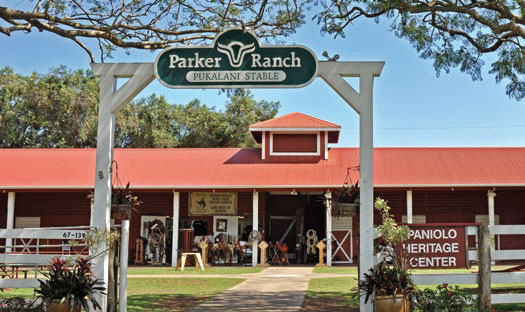Visitors to Waikoloa Beach Resort enjoy the magnificent oceanfront location, multitude of recreational and cultural activities, and delightful shopping and dining.
But as anyone who has explored the island will attest, a rich paniolo (Hawaiian cowboy) and ranch tradition can be found in the green upcountry just a short drive away from the resort, a tradition that is still a driving force in preserving the culture and beauty of the island today.
Parker Ranch is the oldest, largest, and most famous of the island’s ranches. Centered in Waimea, Parker Ranch was founded in 1816 when a young sailor named John Parker Palmer, who jumped ship in 1809 and befriended King Kamehameha I, married Chiefess Kipikane, the King’s granddaughter. The couple was granted two acres of land, and from those humble beginnings a great ranch was born.

The cattle for which the Ranch came to be renowned, and around which the paniolo culture grew, were a gift from British Captain George Vancouver to King Kamehameha I in 1778. Kamehameha set the five cattle free to roam the island, and declared them kapu (off limits). Over the next 20 years, those five multiplied into thousands, causing Kamehameha and his heirs to look for ways to contain the herd, which soon began wreaking havoc on families and gardens.
After participating in the War of 1812, Parker returned to Hawai`i permanently, and brought with him a new, state-of-the-art American musket. Kamehameha gave Parker exclusive permission not only to shoot the now-pesky wild cattle, but to supply meat and hides for local and foreign consumption.
In 1832, Kamehameha III sent one of his high chiefs to California to hire Spanish-Mexican vaquero (cowboys) to help train Hawaiians to rope and handle cattle. Because they spoke Spanish (Español), they were called “paniolo” and the island soon embraced their colorful traditions of music, cuisine, family values, and hard work.
A VISION FOR THE FUTURE

The land which Waikoloa Beach Resort now occupies was once part of the vast Parker Ranch holdings. At its height in the 1930s and ‘40s, Parker Ranch encompassed more than 500,000 acres and 30,000 head of cattle, stretching from the slopes of Mauna Kea down to the lava-strewn shoreline along the Kohala Coast.
But as market conditions and economic realities changed, Richard Smart — the sixth generation heir and last private owner of Parker Ranch — authorized the sale of low-yield pasture land along the coast for resort development. That decision turned out to be brilliant, for in addition to providing Parker Ranch with the funds it needed to continue operations, it also set the table for a tourism-based economy on the island in a time when the sugarcane industry was waning.
The first such sale Smart made was to Laurence Rockefeller in 1963, who purchased the land surrounding Kauna‘oa Bay at the north end of the coast, on which he developed Mauna Kea Beach Hotel. “It is land the cows don’t like but the tourists love — hot and barren,” Smart said in an interview with People. In 1969, the Ranch sold the land surrounding Anaeho‘omalu Bay to the Boise Cascade and Signal companies, and the development of Waikoloa Beach Resort got underway.
According to an article commemorating the Ranch’s 150th anniversary in 2012 by Jan Wizinowich, “This was a hard decision; both areas were special gathering places for the ranch ‘ohana.”
Les Purdy, who has been employed at Waikoloa Beach Resort for more than 43 years, remembers those days well. “There was almost nothing down here back then,” he says. “The Ranch had built a house on the beach near the fishponds [that now front the Marriott].You had to bring in your own water. We’d come in by boat, as there was no road access. But it was great. As a kid I would come down with my family to fish and play on the beach.”
PANIOLO PAST & PRESENT

Purdy’s father, Martin, was a paniolo for Parker Ranch for 33 years, and his grandfather, Ikua Purdy, was one of Hawai`i’s most famous cowboys. Ikua is perhaps best known for winning the steer-roping competition at the 1908 Frontier Days celebration in Cheyenne, Wyoming, competing alongside two other now-legendary paniolo, Archie Ka‘au‘a, and Jack Low. The trio wowed the Mainland crowds with their cowboy hats decorated with colorful flower lei, but more so with their exemplary skills as cattlemen.
A statue of Ikua Purdy is on permanent display at Parker Ranch Center in Waimea and many other examples of the still-active paniolo lifestyle are easy to find. Anyone interested in seeing a master saddle maker at work, for instance, can stop into Kua‘aina Saddlery at Pukalani Stables — the center of Parker Ranch’s horse breeding operation for many years — and strike up a conversation with Pete Gorrell, who will tell fascinating stories of the cowboys of yesteryear, as well as share the secrets of working with leather.
Also at Pukalani Stables is the Paniolo Heritage Center, where a collection of historic saddles, photos, and artifacts from the Ranch’s early days is found, as well as the Paniolo Hall of Fame. Additionally, an annual 4th of July Rodeo takes place at the nearby Parker Ranch Arena; and a traditional Paniolo Parade is held as part of the Hawai`i Island Festival each September, where both horses and riders are adorned with intricate and colorful flower lei on a parade route that leads along the main highway in Waimea.
For visitors to Waikoloa Beach Resort, as well as for appreciative residents who enjoy its graceful ways, the paniolo connection is alive and well on Hawai`i Island.

